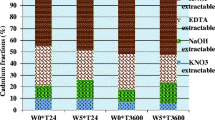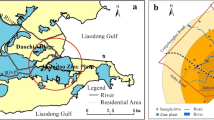Abstract
Sixteen soil samples were collected from the vicinity of an abandoned lead–zinc mine in Shangyu City, eastern China, and the heavy-metal speciation and wheat phytotoxicity in the soils were studied. The results showed that the concentrations of free Cu2+, Zn2+, Cd2+ and Pb2+ were highly variable and ranged from <0.01 to 0.32, 0.06 to 10.62, <0.01 to 1.40 and 0.02 to 37.10 μmol l−1, respectively. The concentrations of soluble Cu, Zn, Cd and Pb ranged from 0.38 to 3.24, 0.72 to 78.74, <0.01 to 1.95 and 0.15 to 639.34 μmol l−1, respectively. The general trend of mean solid/liquid partition coefficient and percentage of free metal ion to total soluble metal concentration were Cu > Pb > Zn > Cd and Cd > Zn > Cu > Pb, respectively. Stepwise multiple linear regression with pH, log(total metal) and log(organic matter) showed that log(total metal) was an important factor that controlled log(free metal ion) and log(soluble metal). Of the variability in log(free Cu2+), log(free Cd2+) and log(free Pb2+), 55.2, 58.6 and 64.3% could be explained by log(total Cu), log(total Cd) and log(total Pb) alone, respectively. Of the variability in log(soluble Cu) and log(soluble Cd), 77.1 and 72.5% could be explained by log(total Cu) and log(total Cd) alone, respectively. Wheat root length was controlled by the various metals with different free and soluble concentrations, and 99.2% of the variability in root length could be explained by concentrations of free and soluble Pb, soluble Cu and total Zn in the soils.



Similar content being viewed by others
References
Atalay YB, Carbonaro RF, Di Toro DM (2009) Distribution of proton dissociation constants for model humic and fulvic acid molecules. Environ Sci Technol 43:3626–3631
Bao SD (2000) Soil agrochemical analysis, 3rd edn. Agricultural, Bei**g, pp 30–38
Cancès B, Ponthieu M, Castrec-Rouelle M, Aubry E, Benedetti MF (2003) Metal ions speciation in a soil and its solution: experimental data and model results. Geoderma 113:341–355
Cao Q, Hu QH, Khan S, Wang ZJ, Lin AJ, Du X, Zhu YG (2007) Wheat phytotoxicity from arsenic and cadmium separately and together in solution culture and in a calcareous soil. J Hazard Mater 148:377–382
Chao L, Zhou QX, Chen S, Cui S, Wang ME (2007) Single and joint stress of acetochlor and Pb on three agricultural crops in northeast China. J Environ Sci (China) 19:719–724
Cui YJ, Zhu YG, Zhai RH, Chen CY, Huang YZ, Qiu Y, Liang JZ (2004) Transfer of metals from soil to vegetables in an area near a smelter in Nanning, China. Environ Int 30:785–791
Cui YS, Du X, Weng L, Zhu YG (2008) Effects of rice straw on the speciation of cadmium (Cd) and copper (Cu) in soils. Geoderma 146:370–377
D Amore JJ, Al-Abed SR, Scheckel KG, Ryan JA (2005) Methods for speciation of metals in soils: a review. J Environ Qual 34:1707–1745
Di Salvatore M, Carafa AM, Carratù G (2008) Assessment of heavy metals phytotoxicity using seed germination and root elongation tests: a comparison of two growth substrates. Chemosphere 73:1461–1464
Geebelen W, Vangronsveld J, Adriano DC, Carleer R, Clijsters H (2002) Amendment induced immobilization of lead in a lead-spiked soil: evidence from phytotoxicity studies. Water Air Soil Pollut 140:261–277
Kalis EJJ, Temminghoff EJM, Visser A, van Riemsdijk WH (2007) Metal uptake by Lolium perenne in contaminated soils using a four-step approach. Environ Toxicol Chem 26:335–345
Krishnamurti GSR, Naidu R (2002) Solid-solution speciation and phytoavailability of copper and zinc in soils. Environ Sci Technol 36:2645–2651
Liu TF, Wang T, Sun C, Wang YM (2009) Single and joint toxicity of cypermethrin and copper on Chinese cabbage (Pakchoi) seeds. J Hazard Mater 163:344–348
Lofts S, Spurgeon DJ, Svendsen C, Tip** E (2004) Deriving soil critical limits for Cu, Zn, Cd, and Pb: a method based on free ion concentrations. Environ Sci Technol 38:3623–3631
Lopez M, Gonzalez I, Romero A (2008) Trace elements contamination of agricultural soils affected by sulphide exploitation (Iberian Pyrite Belt, Sw Spain). Environ Geol 54:805–818
Luo XS, Zhou DM, Liu XH, Wang YJ (2006) Solid/solution partitioning and speciation of heavy metals in the contaminated agricultural soils around a copper mine in eastern Nan**g city, China. J Hazard Mater 131:19–27
Ma Y, Lombi E, Oliver IW, Nolan AL, McLaughlin MJ (2006) Long-term ageing of copper added to soils. Environ Sci Technol 40:6310–6317
Meers E, Unamuno VR, Vandegehuchte M, Vanbroekhoven K, Geebelen W, Samson R, Vangronsveld J, Diels L, Ruttens A, Laing GD, Tack FMG (2005) Soil solution speciation of Cd as affected by soil characteristics in unpolluted and polluted soils. Environ Toxicol Chem 24:499–509
Michaud AM, Chappellaz C, Hinsinger P (2008) Copper phytotoxicity affects root elongation and iron nutrition in durum wheat (Triticum turgidum durum L.). Plant Soil 310:151–165
Nolan AL, Mclaughlin MJ, Mason SD (2003) Chemical speciation of Zn, Cd, Cu, and Pb in pore waters of agricultural and contaminated soils using Donnan dialysis. Environ Sci Technol 37:90–98
Panagopoulos I, Karayannis A, Adam K, Aravossis K (2009) Application of risk management techniques for the remediation of an old mining site in Greece. Waste Manag 29:1739–1746
Salam AK, Helmke PA (1998) The pH dependence of free ionic activities and total dissolved concentrations of copper and cadmium in soil solution. Geoderma 83:281–291
Sauvé S, McBride M, Norvel WA, Hendershot W (2000) Speciation and complexation of cadmium in extracted soil solutions. Environ Sci Technol 34:291–296
Sauvé S, Novell W (2000) Speciation and complexation of cadmium in extracted soil solutions. Environ Sci Technol 34:291–296
Song J, Zhao FJ, McGrath FP, Luo YM (2006) Influence of soil properties and aging on arsenic phytotoxicity. Environ Toxicol Chem 25:1663–1670
Stephan CH, Courchesne F, Hendershot WH, McGrath SP, Chaudri AM, Sappin-Didier V, Sauvé S (2008) Speciation of zinc in contaminated soils. Environ Pollut 155:208–216
Temminghoff EJM, Plette ACC, Van Eck R, Van Riemsdijk WH (2000) Determination of the chemical speciation of trace metals in aqueous systems by the Wageningen Donnan membrane technique. Anal Chim Acta 417:149–157
Weng LP, Temminghoff EJM, Van Riemsdijk WH (2001a) Contribution of individual sorhents to the control of heavy metal activity in sandy soil. Environ Sci Technol 35:4436–4443
Weng LP, Temminghoff EJM, Riemsdijk WHV (2001b) Determination of the free ion concentration of trace metals in soil solution using a soil column Donnan membrane technique. Eur J Soil Sci 52:629–637
Weng LP, Temminghoff EJM, Lofts S, Tip** E, Van Riemsdijk WH (2002) Complexation with dissolved organic matter and solubility control of heavy metals in a sandy soil. Environ Sci Technol 36:4804–4810
**e Z, Wang B, Sun Y, Li J (2006) Field demonstration of reduction of lead availability in soil and cabbage (Brassica chinensis L.) contaminated by mining tailings using phosphorus fertilizers. J Zhejiang Univ Sci B 7:43–50
Zhang XY, Tang LS, Zhang G, Wu HD (2009) Heavy metal contamination in a typical mining town of a minority and mountain area, South China. Bull Environ Contam Toxicol 82:31–38
Zhu YG, Chen SB, Yang JC (2004) Effects of soil amendments on lead uptake by two vegetable crops from a lead-contaminated soil from Anhui, China. Environ Int 30:351–356
Acknowledgments
This study was supported by the National High Technology Research and Development Program of China (No. 2008AA06Z336 and No. 2009AA06Z402) and the Natural Science Foundation of China (No. 20607028).
Author information
Authors and Affiliations
Corresponding author
Rights and permissions
About this article
Cite this article
Cui, Y., Du, X. Soil heavy-metal speciation and wheat phytotoxicity in the vicinity of an abandoned lead–zinc mine in Shangyu City, eastern China. Environ Earth Sci 62, 257–264 (2011). https://doi.org/10.1007/s12665-010-0519-1
Received:
Accepted:
Published:
Issue Date:
DOI: https://doi.org/10.1007/s12665-010-0519-1




